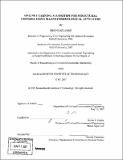| dc.contributor.advisor | Jerome J. Connor. | en_US |
| dc.contributor.author | Laflamme, Simon, M. Eng. Massachusetts Institute of Technology | en_US |
| dc.contributor.other | Massachusetts Institute of Technology. Dept. of Civil and Environmental Engineering. | en_US |
| dc.date.accessioned | 2007-10-22T17:28:50Z | |
| dc.date.available | 2007-10-22T17:28:50Z | |
| dc.date.copyright | 2007 | en_US |
| dc.date.issued | 2007 | en_US |
| dc.identifier.uri | http://hdl.handle.net/1721.1/39271 | |
| dc.description | Thesis (M. Eng.)--Massachusetts Institute of Technology, Dept. of Civil and Environmental Engineering, 2007. | en_US |
| dc.description | Includes bibliographical references (p. 83-84). | en_US |
| dc.description.abstract | Magnetorheological actuators are promising devices for mitigating vibrations because they only require a fraction of energy for a similar performance to active control. Conversely, these semi-active devices have limited maximum forces and are hard to model due to the rheological properties of their fluid. When considering structural control, classical theories necessitate full knowledge of the structural dynamic states and properties most of which can only be estimated when considering large-scale control, which may be difficult or inaccurate for complicated geometries due to the non-linear behaviour of structures. Additionally, most of these theories do not take into account the response delay of the actuators which may result in structural instabilities. To address the problem, learning algorithms using offline learning have been proposed in order to have the structure learn its behaviour, but they can be perceived as unrealistic because earthquake data can hardly be produced to train these schemes. Here, an algorithm using online learning feedback is proposed to address this problem where the structure observes, compares and adapts its performance at each time step, analogous to a child learning his or her motor functions. | en_US |
| dc.description.abstract | (cont.) The algorithm uses a machine learning technique, Gaussian kernels, to prescribe forces upon structural states, where states are evaluated strictly based on displacement and acceleration feedback. The algorithm has been simulated and performances assessed by comparing it with two classical control theories: clipped-optimal and passive controls. The proposed scheme is found to be stable and performs well in mitigating vibrations for a low energy input, but does not perform as well compared to clipped-optimal case. This relative performance would be expected to be better for large-scale structures because of the adaptability of the proposed algorithm. | en_US |
| dc.description.statementofresponsibility | by Simon Laflamme. | en_US |
| dc.format.extent | 88 p. | en_US |
| dc.language.iso | eng | en_US |
| dc.publisher | Massachusetts Institute of Technology | en_US |
| dc.rights | M.I.T. theses are protected by copyright. They may be viewed from this source for any purpose, but reproduction or distribution in any format is prohibited without written permission. See provided URL for inquiries about permission. | en_US |
| dc.rights.uri | http://dspace.mit.edu/handle/1721.1/7582 | |
| dc.subject | Civil and Environmental Engineering. | en_US |
| dc.title | Online learning algorithm for structural control using magnetorheological actuators | en_US |
| dc.type | Thesis | en_US |
| dc.description.degree | M.Eng. | en_US |
| dc.contributor.department | Massachusetts Institute of Technology. Department of Civil and Environmental Engineering | |
| dc.identifier.oclc | 170931934 | en_US |
